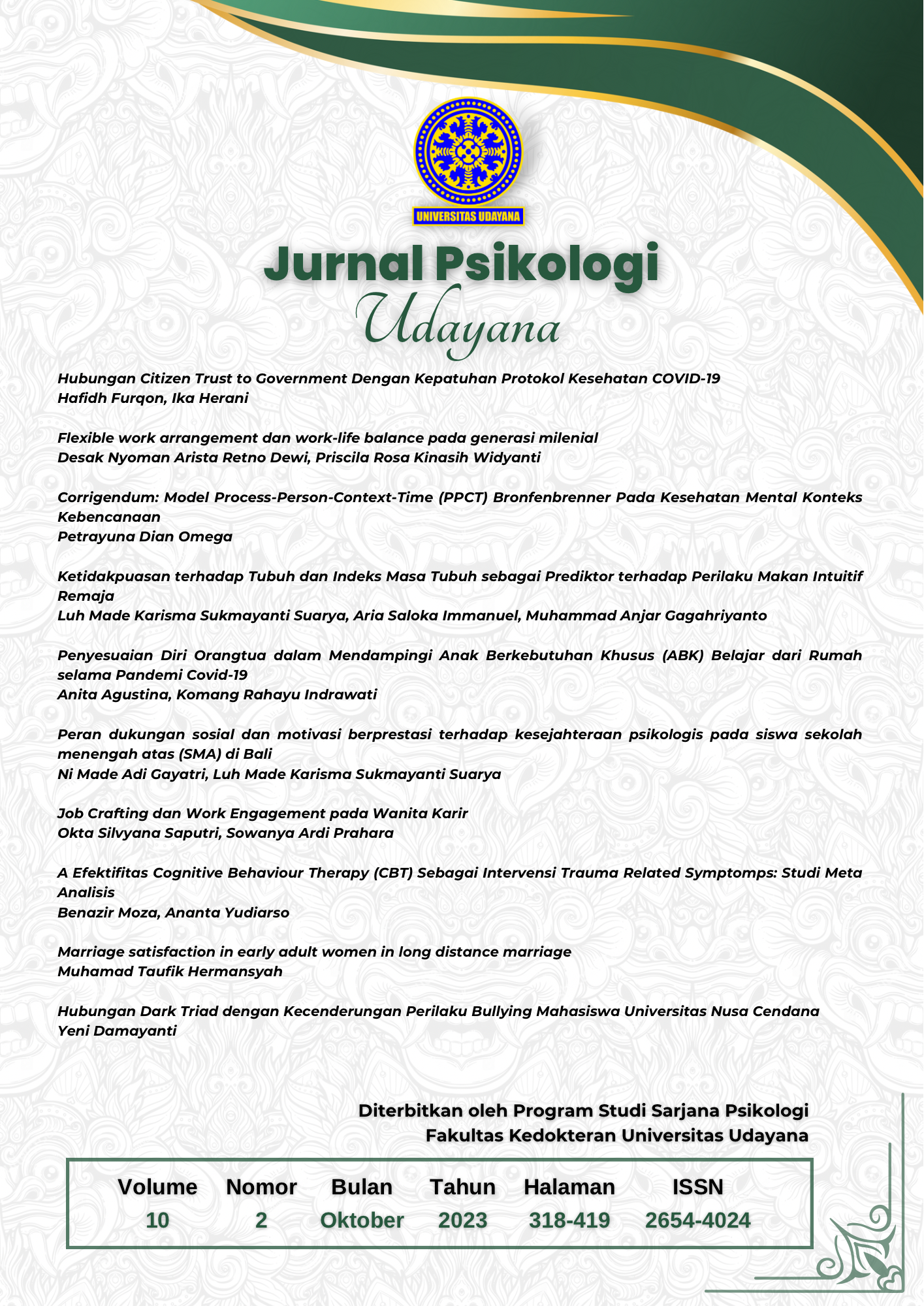Corrigendum: Model Process-Person-Context-Time (PPCT) Bronfenbrenner Pada Kesehatan Mental Konteks Kebencanaan
Abstract
Abstrak
Petra Yuna Dian Omega menemukan kesalahan pada penulisan artikel yang telah terbit yakni ”Model Process Person-Context-Time (PPCT) Bronfenbrenner Pada Kesehatan Mental Konteks Kebencanaan”, Dian Omega, Petrayuna (2023). Dalam catatan ini kami menerbitkan kembali naskah yang telah dikoreksi dalam versi terbaru.
Bencana alam dapat menyebabkan masalah kesehatan mental. Kesehatan mental merupakan hal penting untuk menghadapi situasi tak terduga. Teori kesehatan mental dari Bronfenbrenner khususnya teori proses proksimal Bronfenbrenner dengan model Process-Person-Context-Time (PPCT) dapat memprediksi kesehatan mental karena teori ini dapat mendeteksi hubungan antara faktor-faktor proksimal dan berbagai luaran kesehatan mental. Bronfenbrenner tidak banyak membahas mengenai objek-objek dan simbol-simbol dalam risetnya dimana hanya satu artikel yang mengupas hal tersebut. Jika dibandingkan dengan interaksi interpersonal, interaksi dengan objek dan simbol dapat terjadi tanpa melibatkan orang lain, sehingga sumber daya dan kepemilikan seseorang berperan besar dalam memengaruhi kekuatan dan arah proses proksimal. Penelitian ini menggunakan Diskusi Kelompok Terarah dengan partisipan 10 orang wanita dewasa penyintas bencana alam di Palu Sulawesi Tengah tahun 2018. Hasil penelitian ini menunjukkan pada kondisi bencana banyak orang kehilangan objek dan simbol berharga dalam hidupnya sehingga perlu mengeksplorasi lebih lanjut kesesuaian model PPCT dalam kesehatan mental konteks kebencanaan. Penelitian ini membutuhkan studi lebih lanjut untuk memastikan kesesuaian penggunaan model PPCT dalam kesehatan mental konteks kebencanaan.
Kata kunci: bencana; kesehatan mental; model PPCT; simbol dan objek
Abstract
Natural disasters can cause mental health problems. Mental health is important for dealing with unexpected situations. Mental health theory from Bronfenbrenner especially Bronfenbrenner's proximal process theory with the Process-Person-Context-Time (PPCT) model can predict mental health because this theory can detect the relationship between proximal factors and various mental health outcomes. Bronfenbrenner doesn't talk much about objects and symbols in his research where only one article explores them. When compared with interpersonal interaction, interaction with objects and symbols can occur without involving others, so that one's resources and possessions play a big role in influencing the power and direction of proximal processes. This study used a Focus Group Discussion with participants of 10 adult women survivors of natural disasters in Palu, Central Sulawesi in 2018. The results of this study show that in catastrophic conditions many people lose valuable objects and symbols in their lives so it is necessary to further explore the suitability of the PPCT model in mental health in the context of disaster. This research requires further studies to ascertain the suitability of the use of the PPCT model in mental health disaster contexts.
Keywords: disaster; mental health; PPCT model; symbol and object
Downloads
References
American Psychiatric Association. 2013. Diagnostic and Statistical Manual of Mental Disorders, Fifth edition. (DSM-5). Arlington, VA, American Psychiatric Publishing.
Anderson, C. (2010). Presenting and evaluating qualitative research. American Journal of Pharmaceutical Education, 74(8). https://doi.org/10.5688/aj7408141
Barbour, V. Earthquakes, cyclones, tsunamis, floods and volcanoes- assessing the human impact of each. Speaking of Medicine. PLOS Blogs. 15 October 2014; http://blogs.plos.org/speakingofmedicine/2013/ 04/19/earthquakes-cyclones-tsunamis-floods-and-volcanoes-assessing-the- human-impact-of-each/
Biggerstaff, D. (2012). Qualitative research methods in psychology. Psychology: selected papers, 175-206.
Bonnano, G. (2004). Loss, trauma and human resilience: Conceptual and empirical connections and separateness. American Psychologist, 59(1), 20-28.
Bradshaw, C., Atkinson, S., & Doody, O. (2017). Employing a Qualitative Description Approach in Health Care Research. Global Qualitative Nursing Research, 4. https://doi.org/10.1177/2333393617742282
Bronfenbrenner, U. (1995). Developmental ecology through space and time: a future perspective. In P. Moen,G.H.Elder,&K.L¨uscher (Eds.), Examining lives in context: Perspectives on the ecology of human development (pp. 599–618). Washington, DC: American Psychological Association.
Bronfenbrenner, U. (1999). Environments in developmental perspective: Theoretical and operational models. In S. L. Friedman & T. D. Wachs (Eds.), Measuring environment across the life span: Emerging methods and concepts (pp. 3–28). American Psychological Association. https://doi.org/10.1037/10317-001
Bronfenbrenner, U., & Evans, G. W. (2000). Developmental Science in the 21st Century: Emerging Questions, Theoretical Models, Research Designs and Empirical Findings. Social Development, 9(1), 115–125. https://doi.org/10.1111/1467-9507.00114
Bronfenbrenner, U. (2005). Making human beings human. Thousand Oaks, CA: Sage.
Bronfenbrenner, U., & Morris, P. A. (2006). The bioecological model of human development. In R. M. Lerner & W. Damon (Eds.), Handbook of child psychology: Theoretical models of human development (pp. 793–828). John Wiley & Sons Inc.
Bryant, R. A., & Litz, B. (2009). Mental health treatments in the wake of disaster. Mental health and disasters, 321-335.
Charmaz, K. (2012). The Power and Potential of Grounded Theory. Medical Sociology Online, 6(3), 2–15. Retrieved from http://www.medicalsociologyonline.org/resources/Vol6Iss3/MSo-600x_The-Power-and-Potential-Grounded-Theory_Charmaz.pdf
Connor, K. M., & Davidson, J. R. T. (2003). Development of a new Resilience scale: The Connor-Davidson Resilience scale (CD-RISC). Depression and Anxiety, 18(2), 76–82. https://doi.org/10.1002/da.10113
Creswell, J.W. (2014). Research design: Qualitative, quantitative and mixed methods approaches 4rd ed. Sage Publications, Inc.
Elita, Y., Sholihah, A., & Sahiel, S. (2017). Acceptance and Commitment Therapy (ACT) Bagi Penderita Gangguan Stress Pasca Bencana. Jurnal Konseling Dan Pendidikan, 5(2), 97. https://doi.org/10.29210/117800
Eriksson, M., Ghazinour, M., & Hammarström, A. (2018). Different uses of Bronfenbrenner’s ecological theory in public mental health research: what is their value for guiding public mental health policy and practice? Social Theory and Health, 16(4), 414–433. https://doi.org/10.1057/s41285-018-0065-6
Gray, B., Eaton, J., Christy, J., Duncan, J., Hanna, F., & Kasi, S. (2021). A proactive approach: Examples for integrating disaster risk reduction and mental health and psychosocial support programming. International Journal of Disaster Risk Reduction, 54(January), 102051. https://doi.org/10.1016/j.ijdrr.2021.102051
Gruebner, O., Lowe, S. R., Sykora, M., Shankardass, K., Subramanian, S. V., & Galea, S. (2017). A novel surveillance approach for disaster mental health. PLoS one, 12(7), e0181233.
Handayani, A. M. S., & Nurdin, N. (2021). Understanding Women’s Psychological Well-Being in Post-Natural Disaster Recovery. Medico Legal Update, 21(3), 151-161.
Harwell, M. R. (2011). Research Design in Qualitative/Quantitative/ Mixed Methods. In C. F. Conrad & R. C. Serlin (Eds.), The SAGE Handbook for Research in Education: Pursuing Ideas as the Keystone of Exemplary Inquiry (2nd ed., pp. 147–182). California: SAGE Publications, Inc. https://doi.org/10.4135/9781412961288.n380
Hechanova, R., & Waelde, L. (2017). The influence of culture on disaster mental health and psychosocial support interventions in Southeast Asia. Mental Health, Religion and Culture, 20(1), 31–44. https://doi.org/10.1080/13674676.2017.1322048
Herlina, Malla, H.A.B, Misnah, Suherman, M., & Ratman. (2022). Trauma Healing pada Siswa SMP Pasca Gempa dan Likuifaksi Di Kabupaten Sigi dalam Program Sekolah Tenda. PUE GURU: Jurnal Pengabdian Kepada Masyarakat. Volume 01| Nomor 02 | Desember |2022.
Hugelius, K., Gifford, M., Örtenwall, P., & Adolfsson, A. (2017). Health among disaster survivors and health professionals after the Haiyan Typhoon: a self-selected Internet-based web survey. International Journal of Emergency Medicine, 10(1). https://doi.org/10.1186/s12245-017-0139-6
Iswari, M. (2020). Kegawatdaruratan Psikologis Berupa Tingkat Stres, Kecemasan dan Depresi Korban Gempa, Tsunami dan Likuifaksi di Wilayah Pantoloan Kabupaten Donggala Palu Sulawesi Tengah. maskermedika [Internet]. 13Aug.2020 [cited 12Jan.2022];8(1):46-2. Available from: https://jmm.ikestmp.ac.id/index.php/maskermedika/article/view/377
Kaniasty, K. (2020). Social support, interpersonal, and community dynamics following disasters caused by natural hazards. Current opinion in psychology, 32, 105-109.
Makwana, N. (2019). Disaster and its impact on mental health: A narrative review. Journal of Family Medicine and Primary Care, 8(4), 1414–1417. https://doi.org/10.4103/jfmpc.jfmpc
Markhvida, M., Walsh, B., Hallegatte, S., & Baker, J. (2020). Quantification of disaster impacts through household well-being losses. Nature Sustainability, 3(7), 538–547. https://doi.org/10.1038/s41893-020-0508-7
Math, S., Nirmala, M., Moirangthem, S., & Kumar, N. (2015). Disaster management: Mental health perspective. Indian Journal of Psychological Medicine, 37(3), 261–271. https://doi.org/10.4103/0253-7176.162915
Maeda, M., & Oe, M. (2017). Mental Health Consequences and Social Issues after the Fukushima Disaster. Asia-Pacific Journal of Public Health, 29(2_suppl), 36S-46S. https://doi.org/10.1177/1010539516689695
Mutianingsih, M., & Mustikasari, M. (2019). Dampak Psikologis Gempa Bumi terhadap Kelompok Rentan : Lansia. Jurnal Ilmiah Kesehatan Keperawatan, 15(1), 18. https://doi.org/10.26753/jikk.v15i1.290
North, C. S. (2016). Disaster mental health epidemiology: methodological review and interpretation of research findings. Psychiatry, 79(2), 130-146.
Rasido, I., & Patodo, M. (2020). Post disaster: earthquake, tsunami, liquefaction mental health prevalence of Tadulako University students. Enfermeria Clinica, 30, 214-218.
Rosa, E. M., & Tudge, J. (2013). Urie Bronfenbrenner’s Theory of Human Development: Its Evolution From Ecology to Bioecology. Journal of Family Theory & Review, 5(4), 243–258. https://doi.org/10.1111/jftr.12022
Sarafino, E. P. (2011). Health Psychology : Biopsychosocial Interactions Seventh Edition. Jhon Willey & Sons.
Sherchan, S., Samuel, R., Marahatta, K., Anwar, N., Van Ommeren, M.H., Ofrin, R. (2018). Post-disaster mental health and psychosocial support: experience from the 2015 Nepal earthquake. WHO South-East Asia Journal of Public Health, 6 (1), 22 - 29. World Health Organization. Regional Office for South-East Asia. https://apps.who.int/iris/handle/10665/329595
Sokang, Y. A., Omega, P. D., Novianty, A., Dawan, A., Rully, R. D., & Siantoro, A. (N.D). Reflection of Parents and Children Mentors on Psychosocial Supports in Disaster Context in Palu, Central Sulawesi. (Manuscript in preparation).
Thoyibah, Z., Sukma Purqoti, D. N., & Oktaviana, E. (2020). Gambaran Tingkat Kecemasan Korban Gempa Lombok. Jurnal Persatuan Perawat Nasional Indonesia (JPPNI), 4(3), 174. https://doi.org/10.32419/jppni.v4i3.190
Tudge, J. R. H., Mokrova, I., Hatfield, B. E., & Karnik, R. B. (2009). Uses and misuses of Bronfenbrenner’s bioel. Journal of Family Theory & Review, 1(4), 200.
Zhang, W., Liu, H., Jiang, X., Wu, D., & Tian, Y. (2014). A longitudinal study of posttraumatic stress disorder symptoms and its relationship with coping skill and locus of control in adolescents after an earthquake in China. PLoS ONE, 9(2), 1–7. https://doi.org/10.1371/journal.pone.0088263
Zuhri, M. (2009). Post Traumatic Stress Disorder (Gangguan Stress Pasca Trauma Bencana) Di Jawa Tengah. Jurnal Litbang Provinsi Jawa Tengah, 7(2), 141–150.http://ejournal.bappeda.jatengprov.go.id/index.php/jurnaljateng/article/view/226

This work is licensed under a Creative Commons Attribution-ShareAlike 4.0 International License.
Authors who publish with this journal agree to the following terms:
- Authors retain copyright and grant the journal right of first publication with the work simultaneously licensed under a Creative Commons Attribution-ShareAlike 4.0 International License that allows others to share the work with an acknowledgement of the works authorship and initial publication in this journal.
- Authors are able to enter into separate, additional contractual arrangements for the non-exclusive distribution of the journals published version of the work (e.g., post it to an institutional repository or publish it in a book), with an acknowledgement of its initial publication in this journal.
- Authors are permitted and encouraged to post their work online (e.g., in institutional repositories or on their website) prior to and during the submission process, as it can lead to productive exchanges, as well as earlier and greater citation of published work (See The Effect of Open Access).













